Medicare compensation for home healthcare, patient safety, and increased public recognition of the crucial role respiratory therapists play in healthcare are among the priorities of the 50-year-old American Association for Respiratory Care.
By Sam P. Giordano, President of AARC
For more than 50 years, the American Association for Respiratory Care (AARC) has led the evolution of our profession from the science of health care to the legal recognition of respiratory therapists by the states.
Past To the Present
In 1947 we were known as “oxygen orderlies,” then came to be known as “inhalation therapists” and finally “respiratory therapists.” Today some of you are known as “respiratory care practitioners” because your state licenses you as an RCP. The license that allows you to practice was the result of a movement led by AARC. Licensure helps protect our patients from receiving services from persons whose competency has not been documented. Indeed, tens of thousands of dollars of its members’ resources have been provided to state societies to bolster support of their advocacy for legal recognition of our profession by their respective state governments.
But legal recognition is only a small part of how we have led professional development. A little over 10 years ago, respiratory therapy by protocol was virtually unheard of. At about that time, AARC undertook one of its most profound projects—the development of Clinical Practice Guidelines (CPGs)—which have enhanced the credibility of respiratory therapy as a separate profession that requires highly skilled professionals. CPGs are used as part of patient assessments by you and many of your colleagues and are especially helpful in identifying misallocated treatments.
Controlling utilization of treatments becomes especially important because we can expect to see yet another round of cost containment in health care. About 10 years ago, health care consultants and others predicted that our profession would not exist in 5 years. We have gone from those gloomy predictions to the shortage we currently experience.
That dynamic does not happen by itself. It takes a great deal of education, communication, and collaboration with all stakeholders involved in respiratory therapy, among them federal and state governments, the Joint Commission on Accreditation of Healthcare Organizations (JCAHO), medical specialty organizations, the National Institutes of Health, other health care professionals, and, most important, our consumers.
Leading Toward Tomorrow
Current goals at AARC include getting respiratory therapists included in the home health benefit. This will allow respiratory therapists, in addition to nurses and physical therapists, to make home visits. Why is this important to all respiratory therapists? Because others use our absence from the home care arena as evidence that they are qualified to provide respiratory therapy. AARC has finally convinced Medicare that including respiratory therapists is the right thing to do. We now must get the statutory authority for Medicare to include us. That means we must speak with a louder voice to Congress.
AARC also advocates for patient safety and appropriate utilization of respiratory services. A few months ago, our Board approved a statement on the use of concurrent therapy, or “stacking.” The guidelines, as developed by AARC, provide a blueprint for decreasing work demand (the primary cause of stacking), and organizing a patient self-treatment program under the aegis of the respiratory therapist. This statement is now, in effect, a national standard.
AARC has also made a great effort to increase public awareness of our profession through our ability to advocate for increased awareness of COPD and asthma. Last year, we created a public service announcement with comedian Robert Klein, a COPD patient. We have also joined forces with a coalition to increase awareness of asthma and its many dangers.
There is no such thing as “enough” when it comes to public recognition. We foster efforts by individual members to speak publicly at community meetings and, of course, to the media. If more respiratory therapists participate, our public recognition will increase.
If you are not a member, please join us. AARC has done a great deal to assure that we have a profession up to now. But with the change in the wind in health care and Medicare, we need a louder voice, and that means more members. Our true mission is to realize the vision of having respiratory therapists treated and respected throughout the system as valued members of the health care delivery team, to eliminate ambiguities between our profession and others who claim to be qualified, and to work with government third-party payors and the other stakeholders to advocate for the changes necessary to allow access to the services of respiratory therapists, whenever and wherever needed as deemed appropriate by the attending physician.
RT
Sam P. Giordano is president of AARC. For more information, contact [email protected].









